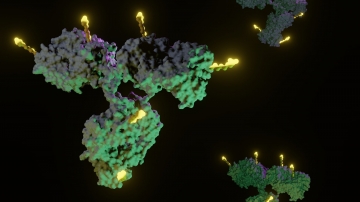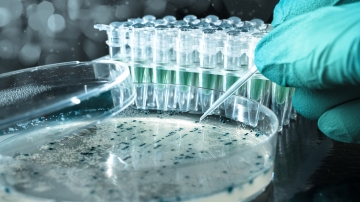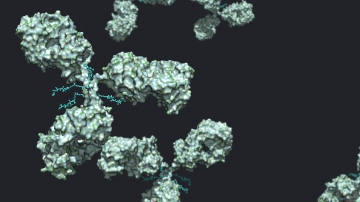Bioconjugates: Examples & Applications
Table of contents
ShowBioconjugates have proven to be very useful in the production of therapeutic drugs, diagnostics and research. Bioconjugate manufacturing, therefore, has enabled new advances in biochemistry.
In this article, we will explain the basics of bioconjugation and the different applications of bioconjugates in pharmaceutical and industrial production.
Bioconjugates – definition & background
Bioconjugates consist of two molecules that have been linked together through a covalent bond established through bioconjugate techniques. As the name already suggests, at least one of the molecules has to be a biomolecule, i.e. a carbohydrate, nucleic acid like RNA, amino acid like DNA or protein. Common carrier molecules used in bioconjugation are aldehydes, antibody-fragments, synthetic polymers, oligosaccharides, oligonucleotides or carbon nanotubes.
Due to their variety of nucleic acids and their potential for useful modifications and reactivity, protein and peptide bindings with disulfide linkage inhabit a special role in bioconjugate reactions. To prevent counter reactions, protein modifications are mostly performed on site-specific cystein or lysine chains which contain thiol and amino groups to prevent inefficient reactions due to polar molecules on the surface of the protein.
Applications & examples of bioconjugates
There are several applications of bioconjugates that are used in different fields. They are applied in the development of therapeutics, vaccines, diagnostics, for research and industrial purposes and have contributed to important advancements in each area. In the following sections, we will explain their different applications and characteristics.
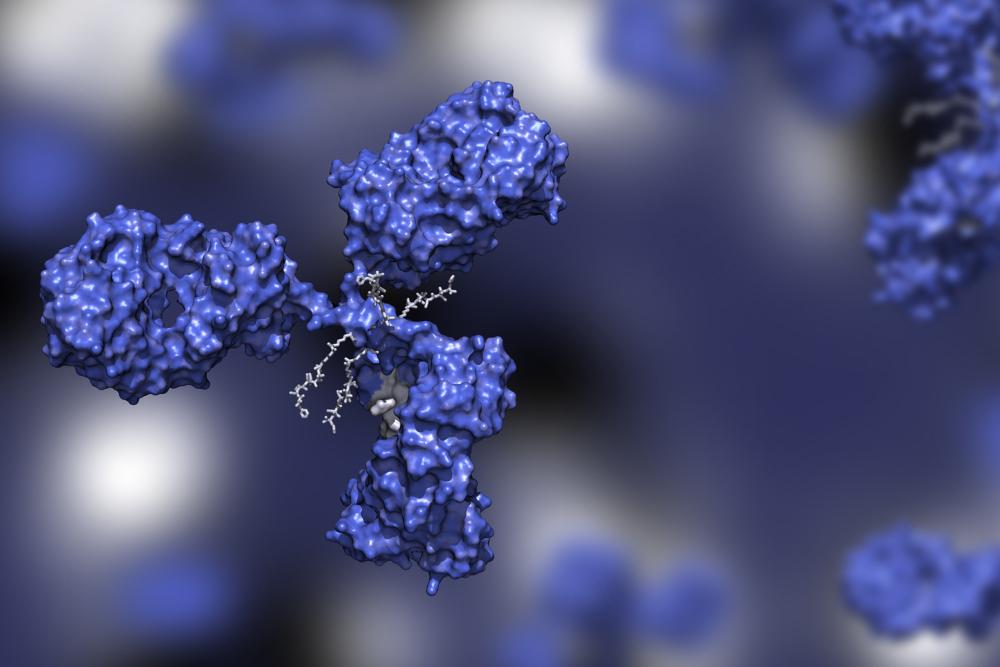
ADCs and other therapeutic bioconjugates
Antibody-Drug Conjugates (ADCs) are highly potent and innovative therapeutic substances successfully used in cancer treatments. Their composition consists of an antibody which is chemically linked to a cytotoxic compound or a biologically active drug. Through their combination, it became possible to combine the sensitive receptor targeting quality and long half-lives of monoclonal antibodies (mAbs) with the aggressive cell-killing abilities of cytotoxic drugs.1
ADC technology enables a most efficient and fast drug delivery to targeted cancer cells as well as efficient toxicity targeting through antibody antigen bindings. Especially cysteine residues are often chosen for chemoselective modification because they rarely occur on protein surfaces and have the ability to react with electron deficient alkynes. Hence, cross linking is less likely to occur.
It can be said that both components of ADCs experience an enhancement in their functionality through protein modulation. In most cases, hydrophilic polymers are combined with other molecules to enhance drug solubility and drug targeting. The number of FDA-approved Antibody-Drug Conjugates keeps on growing as research advances, which is why ADCs are a rapidly growing industry segment in the development of biotherapeutics.
Read more: Examples of Antibody-Drug Conjugates1 2
Bioconjugates in diagnostics
Bioconjugates of proteins in combination with synthetic small molecules are a successful tool in diagnostics to report on ligand bindings with carboxylic acids and amines. In order to detect reactivity, transmission electron microscopy and chromatography are commonly used strategies.
Examples of bioconjugates used in diagnostics are ligations with organic azides or spectrophotometric detection of metal ions such as iron oxide nanoparticles as well as chromogenic and fluorogenic substrate-based assays for enzyme characterization.
Bioconjugation of antibodies with contrast agents is performed through click-chemistry, meaning the reaction of a small molecule with its specific bioreactive peptide.
Research applications of bioconjugates
Bioconjugation is a crucial tool in many research purposes. The synthesis of a modified biomolecule with a substrate reagent can help identify cellular events as well as discover enzyme functions. Bioconjugation strategies involving biomarkers, such as biotin or fluorescent dye, allow for enzymatic labeling of certain functional groups. The marker can be designed to be amine-reactive to grasp onto the site of the protein.3 4
Industrial use of bioconjugates
The industrial use of bioconjugates increases as their use has proven useful for many commercial applications. Thus, they are used successfully in the food industry as a catalyzer of the isomerization of fumaric acid to malic acid. Immobilized enzymes are used in drug manufacturing processes and an integral part of different processes in industrial chemical biology like the production of acrylamide.
What are the advantages of bioconjugates?
There are many advantages linked to the use of bioconjugates in therapeutic drug manufacturing. Protein conjugations with carrier molecules allow for an optimization of chemical properties and the targeting of specific protein interactions. Toxicity is reduced in protein derivatives and drug efficacy can be controlled more easily. Especially the use of PEGylation (polyethylen glycol) combined with therapeutic proteins (as illustrated below) has shown good results in stability.5
Polymer conjugates with liposomes are used to enhance cell life. Further, the targeting of cancer cells could be improved by the combination of hydrophobization and bioconjugation to increase rapid targeting of siRNAs.5 6
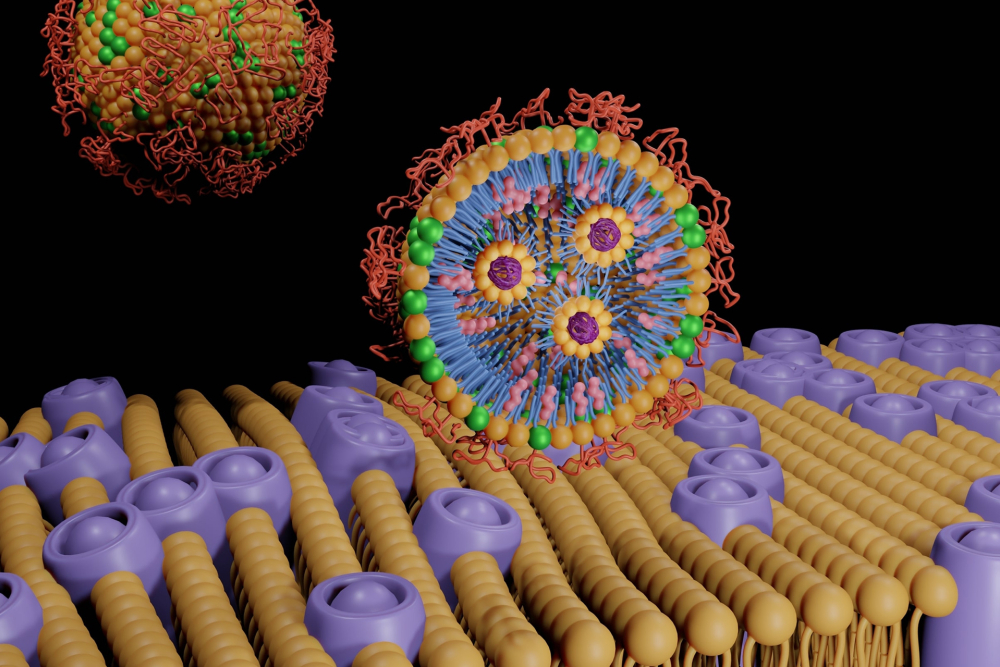
Single-use technology in bioconjugation
Single-use technology is the easiest way to guarantee safe bioconjugation processes. Through safe filling and aliquoting of ADCs in a closed system, obligatory current good manufacturing practices (cGMP) are met and sensitive protein solutions protected.
Fully automated process solutions minimize the risk for decreased product viability or contamination, ensuring process safety in fluid management of ADCs and other bioconjugates. Bioconjugates manufacturing with single-use technologies helps streamlining the process and reduce the probability for product loss. With vendor-independent and scalable single-use technologies, manufacturing processes become more cost and time efficient and product loss can be reduced to a minimum.
- Advances in Bioconjugation, http://dx.doi.org/10.2174/138527210790069839, Published 2009-12-10
- Stepping forward in antibody-drug conjugate development, http://dx.doi.org/10.1016/j.pharmthera.2021.107917, Published 2021-06-24
- Carbon nanotube-assisted optical activation of TGF-β signalling by near-infrared light, http://dx.doi.org/10.1038/nnano.2015.28, Published 2015-03-13
- Choosing an effective protein bioconjugation strategy, http://dx.doi.org/10.1038/nchembio.720, Published 2011-11-16
- Reducing the antigen-independent toxicity of antibody-drug conjugates by minimizing their non-specific clearance through PEGylation, http://dx.doi.org/10.1016/j.taap.2020.114932, Published 2020-02-25
- Bioconjugate Therapeutics: Current Progress and Future Perspective, http://dx.doi.org/10.1021/acs.molpharmaceut.7b00263, Published 2017-05-01






